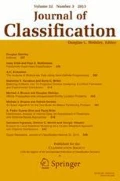Abstract
We propose a new nonparametric family of oscillation heuristics for improving linear classifiers in the two-group discriminant problem. The heuristics are motivated by the intuition that the classification accuracy of a separating hyperplane can be improved through small perturbations to its slope and position, accomplished by substituting training observations near the hyperplane for those used to generate it. In an extensive simulation study, using data generated from multivariate normal distributions under a variety of conditions, the oscillation heuristics consistently improve upon the classical linear and logistic discriminant functions, as well as two published linear programming-based heuristics and a linear Support Vector Machine. Added to any of the methods above, they approach, and frequently attain, the best possible accuracy on the training samples, as determined by a mixed-integer programming (MIP) model, at a much smaller computational cost. They also improve expected accuracy on the overall populations when the populations overlap significantly and the heuristics are trained with large samples, at least in situations where the data conditions do not explicitly favor a particular classifier.
Similar content being viewed by others
Author information
Authors and Affiliations
Rights and permissions
About this article
Cite this article
Asparouhov, O., Rubin, P. Oscillation Heuristics for the Two-group Classification Problem. Journal of Classification 21, 255–277 (2004). https://doi.org/10.1007/s00357-004-0019-7
Issue Date:
DOI: https://doi.org/10.1007/s00357-004-0019-7




